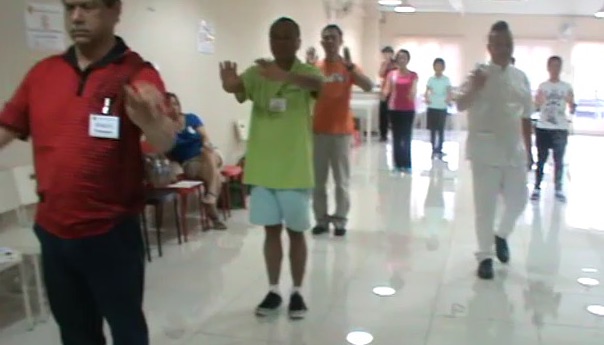OVER-TRAINING AND DEVIATION:
HOW TO PREVENT OR OVERCOME THEM

Chi kung practice in Kuala Lumpur
Difference between Over-Training and Deviation
Over-training means excessive training, when the benefits derived from the training is more than the physical body can take. It usually results in over-cleansing, though over-building and over-nourishing may infrequently occur.
Practitioners must differentiate between over-training and deviation. Deviation results from wrong training. The two main causes of wrong training which results in deviation are tensing muscles and worrying. Deviation seldom occurs in our school.
How does one tell the difference btweeen over-training and deviation. An effective way is to examine the symptoms.
If a student first experiences benefits, then after some time he experiences adverse effects, he is likely to have over-trained. If he has not experienced benefits, but he experiences adverse effects, he is likely to have deviated.
The adverse effects are also different. In over-training, a practitioner finds that the stuff that caused his blockage, like toxic waste, rashes, pimples, and smells, is coming out too quickly for his comfort. This may cause pain, but the pain is quite different from that of deviation.
It may also be excessive cleansing of negative emotions. The practitioner may experience anxiety, fear, grief and other negative emotions. These negative emotions from over-training are also different from feeling of nausea or oppression from deviation, but the difference is subtler.
How to Overcome Over-Training
What should one do when he has over-trained.?
Here are some effective methods:
- Reduce the time of training.
- Reduce the intensity of training.
- Stop training for some time if necessary.
- Spend the excessive energy wholesomely, like spending time with parents and friends, engaging more in out-door activities, performing kungfu sets or combat sequences, and playing games.
As mentioned earlier, deviation seldom happens in our school. The very fact that our students can practice internal arts, means that they can enter into silence. The two requirements for entering silence are not thinking of irrelevant thoughts and not tensing muscles. You may now realize why not worrying and not intellectualizing are the first two of our three golden rules of practice.
How to Overcome Deviation
There are two reasons why people practice internal arts wrongly. One, they stress their mind. Two, they tense their muscles. So, to overcome deviation, just be relaxed mentally and physically.
It may be a big surprise to many people that no matter what action they perform, so long as they relax their mind and body, they will have some effects of internal arts. Of course, for most people, the effects are minimal. However, if they choose special methods, like the internal art methods we use in our school, they will have better results in shorter time.
In our school we have the magic of chi flow. Even when students made mistakes in their practice, their chi flow will wash away any adverse effects due to their mistakes. Here, mistakes refer to those made due to carelessness or forgetfulness. If they consciously go against instructions, like they worry despite knowing not to, they are only asking for trouble. It is best they don’t train our arts.
How to Prevent Over-Training
Prevention is better than cure. An excellent way to prevent over-training is not to progress too fast, or to progress according to what your body can handle. As a general rule, if practitioners can get 30% of what they got in my intensive or regional courses, they would have done very well. I repeat: if practitioners can get 30% of what they got in my intensive or regional courses, they will have done very well.
I have mentioned a few times, and I mean it seriously, what I could achieve in one year at the time when I was already a grandmaster at Shaolin Wahnam Association, a typical Shaolin Wahnam Institute student now can achieve in one month. It took me about 30 years to become a grandmaster, not only in name but acknowledged by the public to have a grandmaster’s level.
If a student now works at 30%, he can attain my level as a grandmaster in 10 years. This means his solo performance is beautiful to watch, he is healthy and full of vitality, and he can defeat masters of any martial art quite comfortably. More significantly he is peaceful and happy every day.
The Magical 30%
Working at 30% is actually quite a lot. There is a lot of attainment in my intensive courses and even in my regional courses. Students attain in a few days what other practitioners, even at their master's level, could not attain in a few years. How many masters having practiced for a few years, for example, can direct their chi to flow at different levels, or develop internal force using various methods, like what our students do in a few days in our chi kung or kungfu courses?
I must add that to reach the level of a grandmaster, I practiced according to what my sifus taught me at least an hour a day, everyday. So, you have to practice for at least 20 minutes a day, everyday for 10 years to reach a grandmaster’s level. If you only practice chi kung, you may practice at least 5 minutes a day.
If you dream to reach a grandmaster’s level, or even a master’s level, in a month, practicing off and on, this is certainly not a school for you. Although we have become so unbelievably cost-effective that I have to tell students to work at only 30% or less, and even that is far ahead of other practitioners, consistent practice is still a must if we want good health, vitality, longevity, peak performance in daily life as well as peace and happiness.

Kungfu practice in Kuala Lumpur
